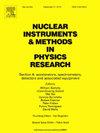费米国家加速器实验室用于μ子g-2实验的固定探针存储环磁力计
IF 1.4
3区 物理与天体物理
Q3 INSTRUMENTS & INSTRUMENTATION
Nuclear Instruments & Methods in Physics Research Section A-accelerators Spectrometers Detectors and Associated Equipment
Pub Date : 2025-03-04
DOI:10.1016/j.nima.2025.170338
引用次数: 0
摘要
FNAL E989实验的目标是在费米国家加速器实验室以前所未有的精度和精度测量μ子磁异常。为了实现这一目标,μ子存储体积中的时间和空间平均磁环境必须优于70 ppb。在西雅图华盛顿大学设计并制造了一种新的脉冲质子核磁共振(NMR)磁强计,用于在此精度下跟踪介子存储环中1.45 T磁场的时间稳定性。它由一组378个基于凡士林的核磁共振探针组成,这些探针嵌入μ子存储环真空室的壁上,以及由现成的模块化射频(RF)组件构建的定制电子设备。给出了核磁共振探针的结构细节,并描述了自定义电子子系统的功能。讨论了磁力计的优异性能指标,经过8年的运行,探针阵列的中位单次射击分辨率保持在650 ppb。本文章由计算机程序翻译,如有差异,请以英文原文为准。
The fixed probe storage ring magnetometer for the Muon g-2 experiment at Fermi National Accelerator Laboratory
The goal of the FNAL E989 experiment is to measure the muon magnetic anomaly to unprecedented accuracy and precision at the Fermi National Accelerator Laboratory. To meet this goal, the time and space averaged magnetic environment in the muon storage volume must be known to better than 70 ppb. A new pulsed proton nuclear magnetic resonance (NMR) magnetometer was designed and built at the University of Washington, Seattle to track the temporal stability of the 1.45 T magnetic field in the muon storage ring at this precision. It consists of an array of 378 petroleum jelly based NMR probes that are embedded in the walls of muon storage ring vacuum chambers and custom electronics built with readily available modular radio frequency (RF) components. We give NMR probe construction details and describe the functions of the custom electronic subsystems. The excellent performance metrics of the magnetometer are discussed, where after 8 years of operation the median single shot resolution of the array of probes remains at 650 ppb.
求助全文
通过发布文献求助,成功后即可免费获取论文全文。
去求助
来源期刊
CiteScore
3.20
自引率
21.40%
发文量
787
审稿时长
1 months
期刊介绍:
Section A of Nuclear Instruments and Methods in Physics Research publishes papers on design, manufacturing and performance of scientific instruments with an emphasis on large scale facilities. This includes the development of particle accelerators, ion sources, beam transport systems and target arrangements as well as the use of secondary phenomena such as synchrotron radiation and free electron lasers. It also includes all types of instrumentation for the detection and spectrometry of radiations from high energy processes and nuclear decays, as well as instrumentation for experiments at nuclear reactors. Specialized electronics for nuclear and other types of spectrometry as well as computerization of measurements and control systems in this area also find their place in the A section.
Theoretical as well as experimental papers are accepted.

 求助内容:
求助内容: 应助结果提醒方式:
应助结果提醒方式:


